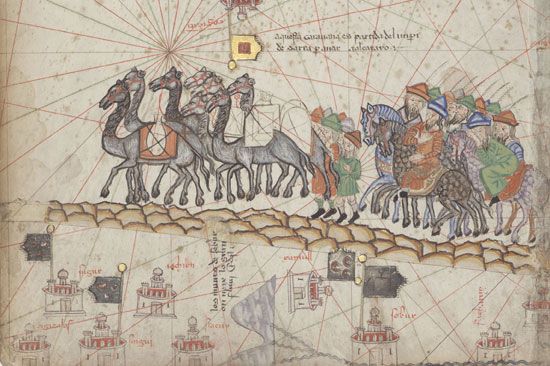Introduction

(1254?–1324). The Venetian merchant and adventurer Marco Polo wrote a fascinating book about his travels in China and other parts of Asia in the late 13th century. The book, Il milione (The Million), is known in English as the Travels of Marco Polo. It was an instant success and was translated into many languages. Fellow Europeans read his accounts of the riches of Asia. They became eager to find sea routes to China, Japan, and the East Indies (islands between mainland Southeast Asia and Australia).
In Marco Polo’s time, very little was known about Asia in Europe. When his book was published, many people thought that it was a fable or a great exaggeration. Over the years, some people have argued that Polo never even reached China. Others have taken his book to be a true and accurate account. Today, scholars generally believe that Polo faithfully recorded what he saw and heard on his travels. However, they believe that much of what he heard secondhand was distorted or fictitious.
Want to learn more about this famous adventurer? Keep reading to find out:
- When did Marco Polo begin his journey to Asia and how long was he gone?
- Who accompanied him on his travels?
- Along what ancient trade route did he make his way east?
- What important historical figure did Marco Polo meet in China?
- What are some of the places Polo visited on fact-finding missions?
- What happened to Polo shortly after his return to Venice and how did he come to write his book?
Early Life

Marco Polo was born in the city of Venice (now in Italy) about 1254. His father, Niccolò Polo, and uncles were merchants who traveled to distant lands to trade. On a long trading expedition Niccolò Polo and Marco Polo’s uncle Maffeo Polo traveled overland as far as Cathay (now northern China). There they met Kublai Khan, the great Mongol emperor of China. Kublai wanted to learn more about the Western world. He asked Niccolò and Maffeo Polo to act as his ambassadors and carry letters to the pope (head of the Roman Catholic Church).
The Polos returned to Venice in 1269. They set out for China again in 1271. This time they took Marco Polo.
The Journey East

From Venice the Polos sailed to Acre (now ʿAkko, Israel). There they received letters for Kublai Khan from a representative of the pope. The Polos crossed the deserts of Persia (Iran) and Afghanistan. Then they mounted the heights of the Pamir Mountains. They descended to the trading city of Kashgar (Kashi), which is now in Xinjiang region of western China. By then, they were traveling on the main part of the ancient trade route known as the Silk Road.

The Polos continued eastward, crossing the dry stretches of the Gobi, a vast desert. Sometime in 1274 or 1275 they arrived at Kublai Khan’s court at his summer capital, Shangdu (now Duolun, in northern China). At that time Marco Polo was about 20 years old.
Travels in Asia

Marco Polo quickly became a favorite of Kublai Khan. He may have moved with the court to the emperor’s winter residence at Dadu (now Beijing, China). Kublai sent him on many fact-finding missions to far places in the empire. These areas included Hangzhou in the southeast, Yunnan in the southwest, and perhaps also what is now Myanmar (Burma). From these lands Marco Polo brought back stories of the people and their lives. He may also have had other official responsibilities, such as inspecting taxes collected from the trade in salt and other commodities.
The Polos became wealthy in China, where they lived for many years. But they began to fear that jealous men in the court would destroy them when the elderly emperor died. About 1290 or 1292 Kublai was preparing to send a Mongol princess to Persia to marry the ruler there. The Polos asked to accompany her on the voyage and, from Persia, to return to Venice. Kublai at first refused but then reluctantly agreed.
Return to Venice
Since there was danger from robbers and enemies of the emperor along the overland trade routes, the Polos began their return trip traveling by sea. They sailed in a fleet of 14 ships. The fleet carried the Polos, the princess, and 600 courtiers and sailors. The fleet traveled southward along the coast of what is now Vietnam and the Malay Peninsula to the island of Sumatra. There the voyage was delayed for several months.
The ships then turned westward. The fleet visited Ceylon (now Sri Lanka) and India before reaching its destination in Persia. The Polos set off by land for Venice. However, along the way they were robbed of most of their earnings from China. When they arrived in Venice in 1295, they had been gone 24 years. Their relatives and neighbors had thought them long dead. Everyone was amazed to see them alive after so many years.
Later Years

Soon after his return to Venice, Marco Polo went back to sea. He was sailing aboard a ship in the Mediterranean when it was captured by forces of the trading city of Genoa, a rival of Venice. He was thrown into a Genoese prison. There he wrote his book with help from another prisoner, Rustichello, who was a writer of romances.
Polo was soon released from prison. He returned to Venice. The subsequent publication of his book provided Europeans with one of their first detailed descriptions of Asia. The book gave fascinating insights into the region’s peoples and goods.
In later years Polo continued to engage in trade. His name appears in the court records of his time in many lawsuits over property and money. He died in Venice on January 8, 1324.
Explore Further
Find out more information in these articles:

